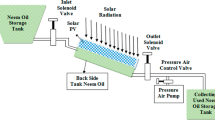Abstract
A Venus sample return mission is very interesting from a scientific point of view, for example, analysing the composition of the soil will help us to understand the differences between Venus and Earth. However, such a mission is extremely challenging. On Venus the ground conditions are very harsh (460 °C, 9.6 MPa), the Delta V requirement from surface to orbit is close to the Earth case, and atmospheric drag means that a rocket launch must occur above 55 km and so an Unmanned Aerial Vehicle is required to lift the samples to rocket altitude. Sample return missions have been studied in depth by NASA/JPL and ESA, and in the former case the proposed profile involves several critical points, each with a significant probability of failure:
-
Thermal exposure during sample drilling and ascent to launch altitude.
-
Fast balloon inflation, at 55 km altitude.
-
Difficulties to perform a rendezvous with an orbital vehicle if the upper stage is not manoeuvrable.
The purpose of this paper is to propose new methods for meeting the challenge at each critical step and reducing the risks to such a mission. In particular, we propose two innovative methods for thermal control on the lander: advanced thermal insulation and phase change materials.












Similar content being viewed by others
Data availability
The data will be made available upon reasonable request.
References
Coradini, M., G.E.N. Scoon and J.-P. Lebreton (1998) Venus Sample Return Assessment Study Report, ESA. Report SCI (98)3, June 1998, Noordwijk, the Netherlands.
Pätzold, M., Häusler, B., Bird, M.K., Tellmann, S., Mattei, R., Asmar, S.W., Dehant, V., Eidel, W., Imamura, T., Simpson, R.A., Tyler, G.L.: The structure of Venus’ middle atmosphere and ionosphere. Nature 450(7170), 657–660 (2007)
Rodgers, D. et al. (2000) Venus Sample Return: A Hot Topic. Jet Propulsion Laboratory, Pasadena, California. 20 – 25 March 2000. Big Sky, MT, USA. IEEE Aerospace Conference. Proceedings (Cat. No.00TH8484).
Sagdeev, R.Z., Moroz, V.I.: Venera 13 and Venera 14. Sov. Astron. Lett. 8(4), 209–210 (1982)
Streed, E.R., G.R. Cunnington, C.A. Zierman (1966) Performance of multilayer insulation systems for the 300 to 800 K temperature range. In G.B. Heller (Eds) Thermophysics and Temperature Control of Spacecraft and Entry Vehicles. ISBN 978–1–56347–867–3.
Sweetser, T., J. Cameron, G.-S. Chen, J. Cutts, B. Gershman, M.S. Gilmore, J.L. Hall, V. Kerzhanovich, A. McRonald, E. Nilsen, W. Petrick, D. Rodgers, C. Sauer, B. Wilcox, A. Yavrouian, W. Zimmerman and the Advanced Projects Design Team of the Jet Propulsion Laboratory (1999) Venus Surface Sample Return: A Weighty High-Pressure Challenge. AAS Conference Proceedings, AAS 99–356, available at NASA NTRS 20010003946.
Talamoni, Y., E. Gautronneau, S. Larrieu, X. Bertrand (2021) The P120C SRM Nozzle Qualification and Manufacturing Transition Phase. SPACE PROPULSION 2020+1 Conference. Estoril, Portugal / 17–19 MARCH 2021.
Talbot, C., P. Gonzalez Gotor, A. Ruiz Merino, L. Froebel (2009) “ALDEBARAN”, A Launch Vehicle System Demonstrator. 7th Responsive Space Conference, April 27–30, Los Angeles, CA.
van den Berg, M., P. Falkner (2007) Study overview of the Venus Entry Probe. An ESA Technology Reference Study. SCI-AP/2006/173/VEP/MvdB. 27/02/2007. Available at https://sci.esa.int/documents/34923/36148/1567255430774-VEP_Study_Overview_2_3_2007.pdf
Wilson, C. and T. Widemann (2019) Venus: key to understanding the evolution of Terrestrial Planets. a response to ESA's call for white papers for the Voyage 2050 long-term plan in the ESA Science Programme. Experimental Astronomy, this volume.
Zacny, K., Y. Bar-Cohen, K. Davis, P. Coste, G. Paulsen, S. Sherrit, J. George, B. Derkowski, S. Gorevan, D. Boucher, J. Guerrero, T. Kubota, B.J. Thomson, S. Stanley, P. Thomas, N. Lan, C. McKay, T.C. Onstot, C. Stoker, B. Glass, S. Wakabayashi, L. Whyte, G. Visentin, E. Re, L. Richter, M. Badescu, X. Bao, R. Fincher, T. Hoshino, P. Magnani, C. Menon (2009) Extraterrestrial Drilling and Excavation. In Drilling in Extreme Environments (eds Y. Bar-Cohen and K. Zacny) https://doi.org/10.1002/9783527626625.ch6.
Acknowledgements
The authors wish to thank Dr Chris Arridge and Karen O’Flaherty for useful remarks and suggestions.
Funding
This work has not been funded, it was made by the free contribution of the authors.
Author information
Authors and Affiliations
Corresponding author
Ethics declarations
Conflict of interest
The authors declare that they have no conflict of interest.
Additional information
Publisher's note
Springer Nature remains neutral with regard to jurisdictional claims in published maps and institutional affiliations.
Rights and permissions
About this article
Cite this article
Valentian, D., Koppel, C., Mairet, P. et al. Venus sample return mission revisited. Exp Astron 54, 597–616 (2022). https://doi.org/10.1007/s10686-022-09858-5
Received:
Accepted:
Published:
Issue Date:
DOI: https://doi.org/10.1007/s10686-022-09858-5




